PPC
How to Generate Leads: 41 Strategies That Work (Paid & Free!)

Think about the last big ticket purchase you made. Did you find out about the business or product and then immediately become a customer? 61% of marketers say generating traffic and leads is their number one challenge.
Table of contents
What is lead generation?
Lead generation is the process of capturing the contact information of potential customers for your business. It often takes multiple encounters with a business before a person becomes a customer, so with their contact information, you can initiate these encounters—and make them impressionable—through useful content.
The idea is to build trust and stay top of mind so that eventually, when these leads are ready to buy, they choose you.
Lead generation is especially important for businesses that involve:
- Big ticket purchases: real estate, financial services, solar
- High returns on new leads: law firms
- Slower sales cycle: B2B SaaS
- Ecommerce: coupons
How to generate leads: The basics
Every lead generation strategy is going to look different from business to business, but regardless, there are four fundamentals that apply across the board.
1. Offer
Every lead generation strategy needs something that your prospective leads feel is worth exchanging their contact information for—also known as the lead magnet. In addition to being of value, make sure it’s also relevant to your products and services so that you’re attracting quality leads.
Examples of offers include:
- Content (reports, checklists, guides, cheat sheets)
- Free tools (calculators, graders, quizzes)
- Newsletters
- Swag
- Free trials
- Demos
- Free consults
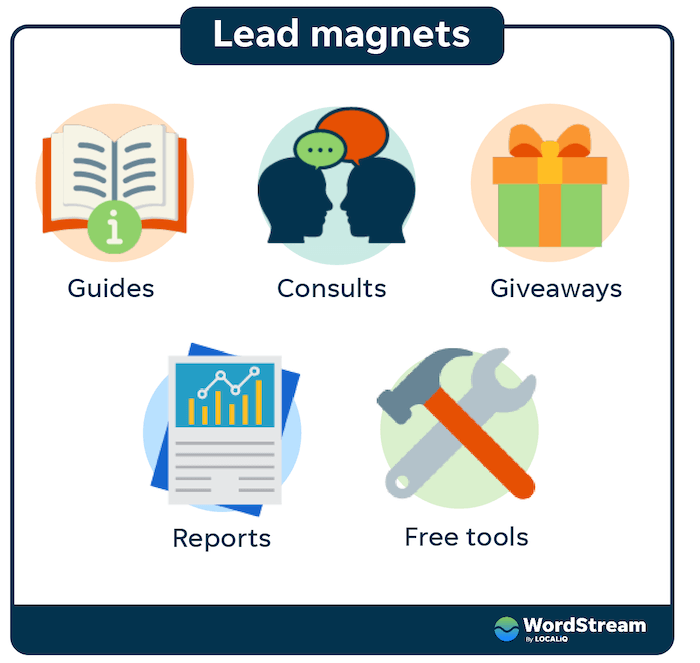
The best offer will vary depending on the channel you’re promoting it on (such as your website, search engines, or social media), the segment of your audience you are targeting, and their intent and mindset.
2. Landing page and form
Your landing page is the page the person lands on after clicking the call to action button for the offer. This page contains all of features and benefits of the offer, plus the form the user fills out to obtain it.
Tips for your lead generation landing pages:
- Make sure the messaging is the same as the ad or piece of content leading to it.
- Keep form fields to a minimum.
- Test your forms to make sure they populate leads in your CRM.
- Use anything BUT “submit” as your CTA button language
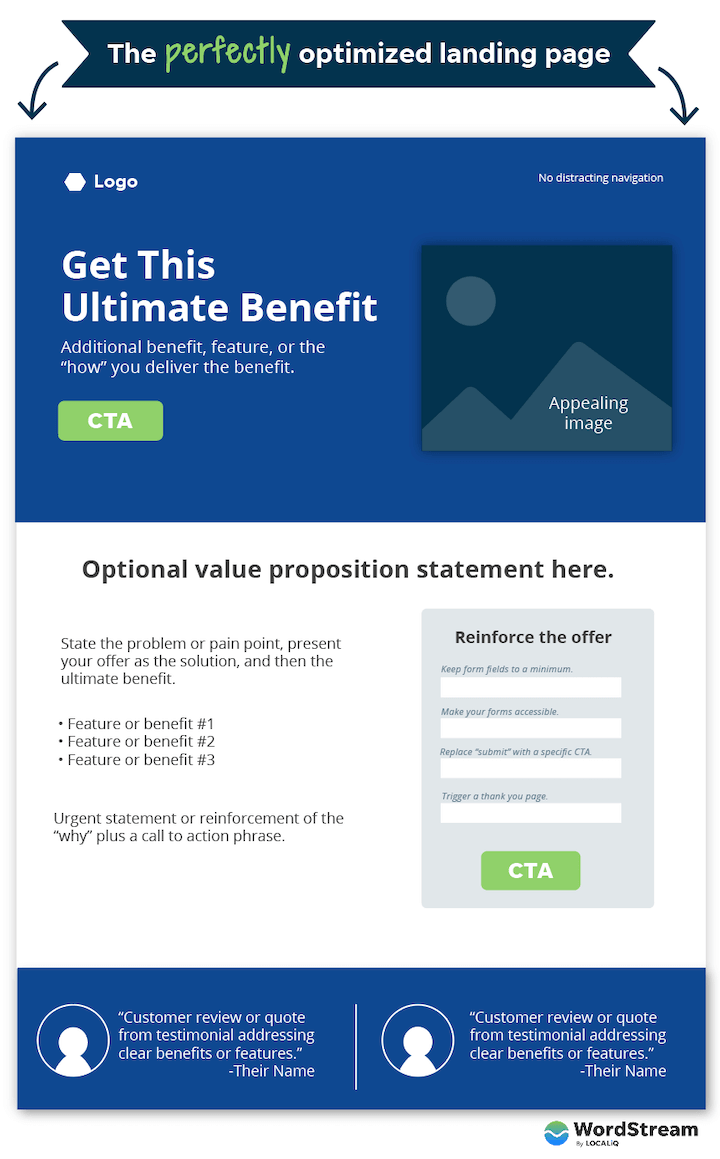
3. Thank you page
The thank you page is where the user lands after submitting their contact information. You achieve this by making the URL for the form submit button the thank you page.
A good thank you page has the following qualities:
- Confirms for your potential customer that the transaction is complete.
- Thanks them for their interest in your business.
- Contains the offer such as a link to a PDF or the steps to obtain it (like check your inbox).
- Promotes a secondary offer.
- Tracks conversions.
4. Tracking and CRM
Generating leads is only the first step. You need to follow up with them and nurture them so they become customers. If you have a small business, a spreadsheet may do. But even then, it’s hard to keep track of each individual lead’s journey. And this is important because you want to cater your communication to whichever stage they’re at, and whatever touchpoint brought them to your business. A customer relationship management (CRM) or lead management software can help you automate personalized and meaningful communication.
How to generate leads with your website
While there are many ways to generate leads for your business off your website, the majority of your leads will be captured on it. The idea is to optimize each page for lead generation and then drive relevant traffic to your site.
Step #1: Optimize your website to generate leads
Ideally, every page on your website should provide an opportunity for a visitor to become a lead. This can be done in a tasteful way using a mix of strategies. For example:
- Anchor text: Plain old text links in the body copy of your pages can capture high-intent leads who are actually reading your content line by line.
- Buttons: Be sure to use active language and appropriate color contrast so they stand out.
- Embedded forms: Rather than always sending users to a landing page, you can embed one- or two-field forms right on a page of your site, such as at the bottom or side rail for a newsletter signup.
- Chatbots: Before connecting a user to a live person, you can use a chatbot to collect their information in case of disconnect. Or you can have a bot promoting an offer that captures the information and shares the offer all in that one chat.
- Popups: [Non-annoying] pop-ups are great for capturing leads. They can have a form embedded right in them or link to a landing page. Popup software that allows you to cater offers to particular blog categories and page targeting is ideal.
- Sticky widgets: Sidebars and bottom rails that persist no matter which page a user is on.
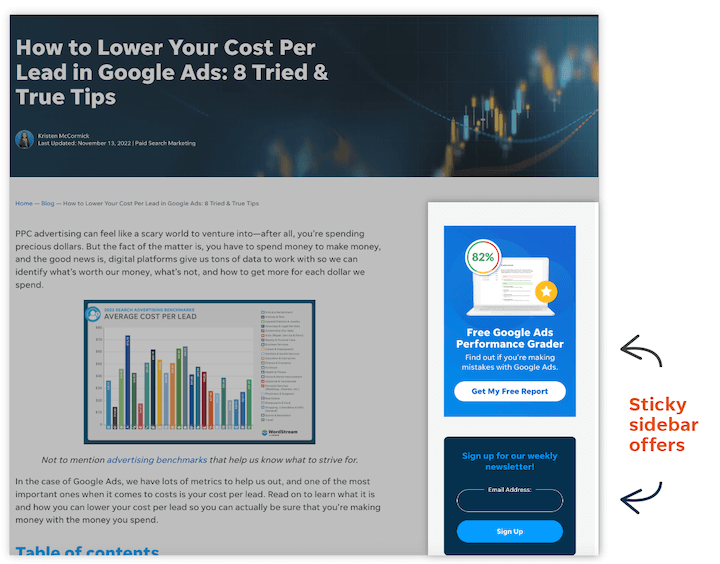
Step #2: Match offer with intent
Keep in mind that a visitor’s intent will be different on different pages of your site, so cater your offers accordingly.
- Homepage: Your homepage should have a prominent call to action for your main product or service above the fold, with secondary lead-generating offers below the fold. However, if you are a lead gen-focused business, your primary offer may be a lead-focused offer such as a free consult or trial.
- Contact us page: The only lead-generating offer on your contact us page should be a contact form. Rather than providing an email address, replace it with a form that will send a notification to your email.
- Products and services page: Be careful with your products and services pages. The main CTA on these pages should be to purchase the product or service, but you might want to use a live chat widget for those who may have questions before committing.
- Testimonials page. Your testimonials page will attract well-qualified traffic, but you may not want to interrupt their research process with other offers. You might leave a chat widget on this page or test out gating your success stories. Those who care enough to fill out a form to view the story are going to be highly interested in your business.
- Blog posts: Intent to buy on your blog is going to be lower than intent to learn. Your lead magnets on your blog posts should be lower-funnel, such as guides, checklists, or newsletter signups.

Step #3: Drive traffic to your lead-generating website
Once your website is optimized to generate leads, now it’s time to optimize it to generate traffic. Not just any traffic, but qualified traffic. That is, visitors who are going to be most interested in your lead magnets. This means employing a combination of SEO and business promotion strategies, such as:
- Blog posting: Write high-quality blog posts containing information that your target audience is looking up online. Use keyword research tools to pick the best topics to target.
- Backlink building: Well-targeted content will get found on search engines, but earning backlinks to that content from other reputable sights will help it to rank higher and accumulate even more relevant traffic.
- Local SEO: Optimizing your listings is a top lead generation strategy for local businesses. Prioritize your Google Business Profile and use our tips to optimize your listing.
- Social media: Social media is a powerful lead generation tool! Post regularly with links to your blog posts. Engage with your current followers, share others’ content, using hashtags, and run contests. More followers = more traffic. Tips to generate B2B leads from LinkedIn here.
- Influencer collaborations: Partner with a popular influencer who has a large following in your market. Whether that’s through a guest post, a video, or an AMA, this can help drive traffic from a relevant audience to your social channels and website.
- Newsletter emails: Send out interesting, informative, and useful emails with links to your website and landing pages. People on your email list are already leads for your business, but it’s important to keep them coming back to your site and engaging with other offers, so they can move further down the funnel and keep your business at the top of their minds.
- Paid traffic campaigns: Most ad platforms have some form of traffic objective that allows you to drive visitors to your site, but these platforms also tend to have lead gen or conversion objectives, which are going to be more useful. We’ll talk about those next.
More ways to generate leads online
The above strategy is essential for generating leads for your business, but it is more or less a passive approach: turn your website into a lead engine that’s always working for you, and then send users there where they can basically choose their own adventure.
This is essential, but here are some more lead generation ideas that are more active and targeted. Take a look:
Run conversion campaigns
Rather than sending people to your website to just come across your lead magnets (like guides, checklists, and free tools), you can directly promote those offers using paid media campaigns through search, social, display, and YouTube ads. These are the “conversion” campaigns I talked about a little bit ago. Be sure to create dedicated landing pages for those offers, catered to that channel and that specific target audience.
Why spend money to generate leads rather than customers? Because you can nurture these leads. And with the targeting capabilities of online advertising, you can capture highly qualified, highly nurturable leads.
Experiment with lead form ads
Most ad platforms offer a lead form ad (Facebook offers lead ads, Google offers lead form extensions), which means that when a user clicks on the ad, they aren’t directed to a landing page on your site; instead, a form appears right on that platform. This lower-friction approach can be useful in generating higher volumes of leads than with landing page campaigns, but you do have to be mindful of lead quality with these.
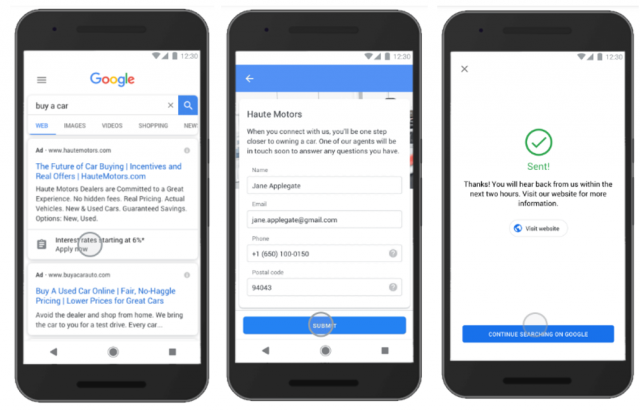
Here’s an example of a lead form ad on Google.
Host contests & giveaways
Everyone likes free stuff, so what better way to generate leads than by doing contests and giveaways? Just be sure to offer something relevant to your business, and to have a way of collecting contest entrant contact information. Otherwise, you’re only gaining followers, not leads.
While they may not immediately generate your highest quality leads, contests and giveaways help you to build an audience as well as brand affinity.
Run referral programs
Establish a referral program with your existing customers. This is a great customer engagement strategy that will also bring new leads through the door.
More ways to generate leads offline
Just because your lead-generating powerhouses (your website, search engines, and social) are online does not mean that all of your strategies should take place there. Do not ignore these good old-fashioned offline marketing strategies for generating leads!
Capitalize on events
- Sponsor local events: Sponsor events that are applicable to your business, such as a bike shop sponsoring a local race. Include your contact information on your signage and swag, or set up a stand where interested prospects can interact with you and sign up for your newsletter.
- Attend industry events: Industry trade shows and networking events can connect you to a large number of new potential prospects that you can follow up with and nurture in the days and weeks afterward. Building relationships with other business owners and industry professionals can also help you in your lead generation efforts—just don’t make that the goal of the relationship. Follow our networking strategies and tips for more on that front!
- Host your own events: Host events at your location or partner with a brick-and-mortar business if you don’t have one. Think tutorials, seminars, free sessions, family fun nights. Have a signup sheet at the event for your email list or collect contact information for a giveaway that night.
Try out print ads
Break through the online clutter by trying print ads in a local newspaper. To find the right publications for your print ads, consider the volume and frequency of distribution, the characteristics of its readers, and the cost. Contacting your business via a print ad or postcard may have a little more friction than an online CTA, but you may also find that the people who take the action despite the friction are high-quality leads.
Send direct mail
A well-designed and properly targeted postcard or care package can be a great way to stand out from your competitors. Just make sure you include a specific CTA—to use a coupon in-store, to go to a specific landing page on your site, or to use a specific promo code.
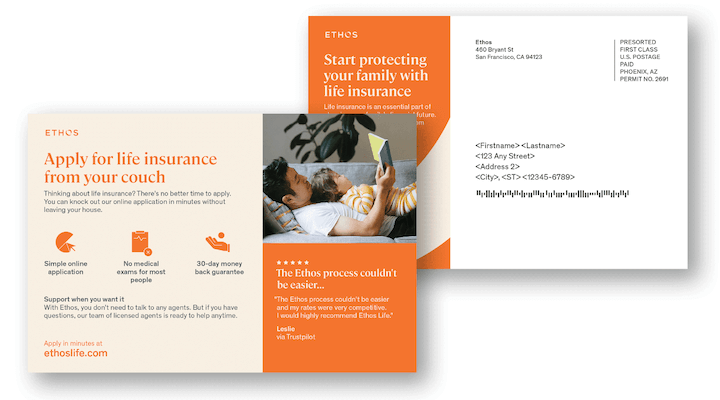
Give out swag
Free and useful items with your brand and contact information are a great way to reach leads for your business. Try sunglasses, frisbees, hats, drink koozies, pens, notepads, and more. You can hand out swag at your store, at special events, or use it for competition prizes. You can also use signs, flyers, and car wraps on your own properties.
Reach out to local media outlets
If you’re a small or local business, see what kind of levers you can pull within your community:
- Local radio ads: Similar to online ads, you can target by audience and even time of day.
- Local TV: Local news outlets regularly feature small businesses on their morning shows … often for free! Reach out to local TV and radio stations and find out how to get on air.
- Local press: Have a story-worthy event or cause to talk about, a unique take on a current event, tips for your community, or just a cool founding story? Pitch to the press and see if you can get some PR, whether through a press release or feature story.
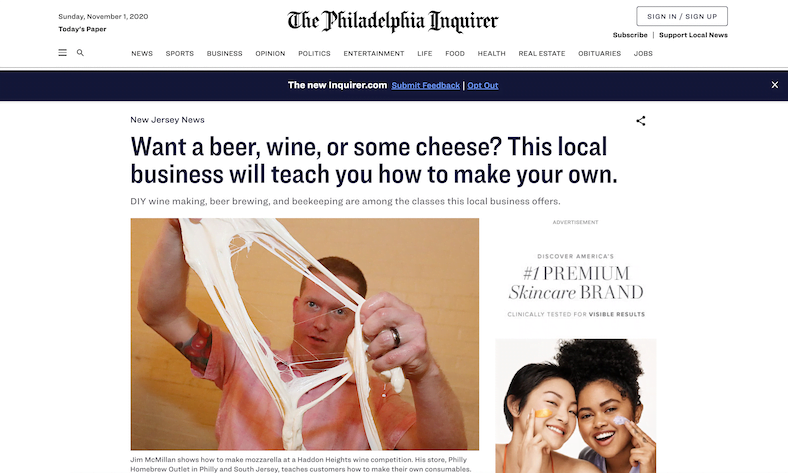
Provide excellent customer service
Referral programs are great and all, but the best referral you can get? From a customer who was just so dang pleased with the service you provided, that they took it upon themselves to recommend you to others. Provide products and services that are truly a cut above the rest, and you’ll find yourself attracting new leads organically.
Final tips on generating leads
As I mentioned earlier in this post, generating leads is only the first part of the equation. Proper lead management is the key to ensuring you turn those leads into customers. That said, here are some final tips for a solid lead generation process:
- Track everything: Use UTMs, campaign IDs, or other tracking methods so you can understand which offers are driving the most leads and which ones aren’t worth your time or money.
- Track conversion from lead to customer: It’s important to note not only the offers that are generating the most leads, but also the offers that have the highest lead-to-customer conversion rate.
- Follow up with your leads: The whole point of lead generation is to turn them into customers for your business. This rarely happens on a first encounter, so be sure to follow up with your leads more than once—catering your communication to the offer that led them to your business.
How to generate leads, the big list:
- Reports
- Checklists
- Guides
- Cheat sheets
- Webinars
- Newsletters
- Calculators
- Graders
- Quizzes
- Other free tools
- Swag
- Free trials
- Demos
- Consults
- Case studies
- Courses
- Anchor text
- Buttons
- Embedded forms
- Chatbots
- Sidebars and bottom rails
- Blogging
- Backlinks
- Listings
- Social posting
- Influencer collaborations
- Paid conversion campaigns
- Lead form ads
- Contests and giveaways
- Referral programs
- Sponsor events
- Attend events
- Host events
- Print ads
- Direct mail
- Swag
- Car wraps and signage
- Radio ads
- TV ads
- Local press
- Customer service

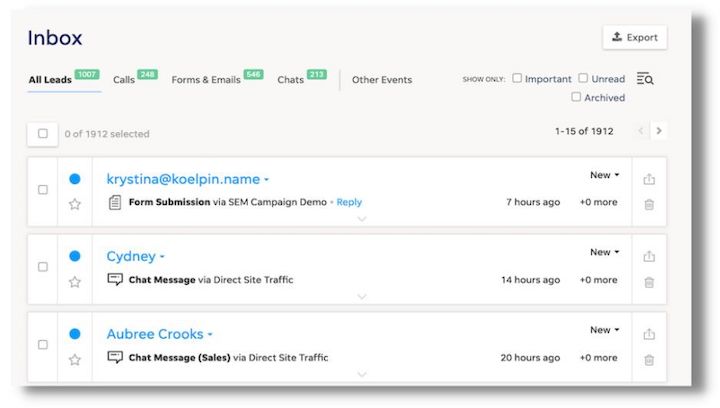
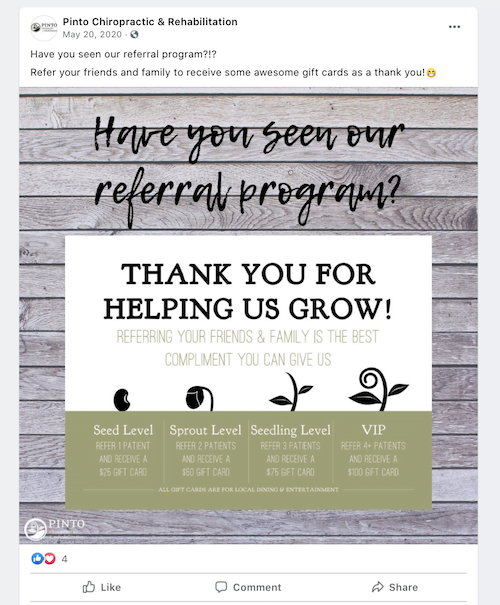












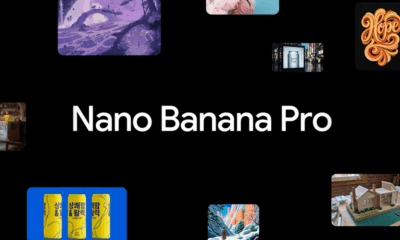





You must be logged in to post a comment Login